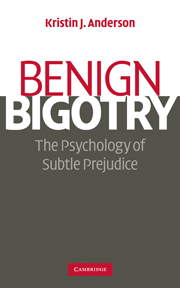Book contents
- Frontmatter
- Contents
- Acknowledgments
- Introduction: The changing place of prejudice: a migration underground
- 1 “Those people all look alike”: The myth of the other
- 2 “They must be guilty of something”: Myths of criminalization
- 3 “Feminists are man-haters”: Backlash myth-making
- 4 “Gays flaunt their sexuality”: The myth of hypersexuality
- 5 “I'm not a racist, I'm colorblind”: The myth of neutrality
- 6 “Affirmative action is reverse racism”: The myth of merit
- Conclusion
- Index
1 - “Those people all look alike”: The myth of the other
Published online by Cambridge University Press: 05 June 2012
- Frontmatter
- Contents
- Acknowledgments
- Introduction: The changing place of prejudice: a migration underground
- 1 “Those people all look alike”: The myth of the other
- 2 “They must be guilty of something”: Myths of criminalization
- 3 “Feminists are man-haters”: Backlash myth-making
- 4 “Gays flaunt their sexuality”: The myth of hypersexuality
- 5 “I'm not a racist, I'm colorblind”: The myth of neutrality
- 6 “Affirmative action is reverse racism”: The myth of merit
- Conclusion
- Index
Summary
I watch CNN but I'm not sure I can tell you the difference in Iraq and Iran.
Alan Jackson's “Where Were You?”Immediately after the September 11, 2001, attacks in the United States, Sikh Americans became targets of hate crimes. Sikhism, a religion that originated in India, is not related to Islam, the religion of the hijackers who committed the attacks. Sikh men wear their hair long and in a turban or tied back. For some Americans, turbans worn by Sikh men resembled the head covering of Osama bin Laden, the Saudi who took responsibility for the attacks. Suddenly, Sikhs were the victims of crimes ranging from a woman trying to pull a man's turban off to beatings, bombings, and killings. To the perpetrators of these attacks against Sikh Americans, Sikhs may as well have been Osama bin Laden himself – even though they did not share his religion, ethnicity, or nation of origin. To many Americans, people over there (i.e. the Middle East and Asia) are, indeed, all alike. To many Americans Sikhs look more like Middle Easterners, Arabs, or Muslims than they do Americans, and therefore they must be the enemy.
“They all look alike” is a fairly ordinary expression, and a phenomenon most people have encountered in one situation or another. In essence, it reflects our general inability to distinguish individuating features of members of groups to which we do not belong. This idea is applied to nearly any sort of group or category, from race to nationality to religious affiliation.
- Type
- Chapter
- Information
- Benign BigotryThe Psychology of Subtle Prejudice, pp. 22 - 80Publisher: Cambridge University PressPrint publication year: 2009



